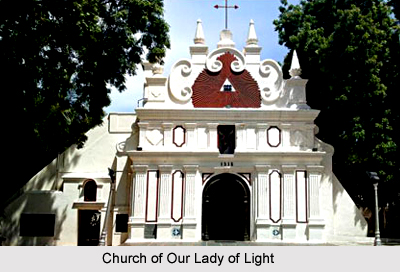 Church of Our Lady of Light, a Roman Catholic shrine located in Chennai in Tamil Nadu. The church is also known as Luz Church by the local people. The word has been derived from the Portuguese name Nossa Senhora da Luz. The church is situated in the Mylapore local of Chennai. At that time the area remained completely surrounded by dense forest. It is for this reason that the church is sometimes known as Kaatu Kovil in Tamil meaning a jungle temple. It is said that earlier the area remained covered with mangroves but now it has become a well developed locale. The road on which the church is located has been named as Luz Church road after the church itself. The Santhome Basilica, where Apostle Thomas is said to have been buried is located close to the church almost 1.5 kms away. The Church of Our Lady of Light dates back to the ancient times. The Portuguese had built the church in the year 1516 and is regarded as one of the oldest churched of Chennai. The building stands as one of the oldest European monuments of India. Church of Our Lady of Light has been built in the 16th century and is associated with the legend of the arrival of the missionaries on this land. It has been built in honour of `Our Lady of Light.`
Church of Our Lady of Light, a Roman Catholic shrine located in Chennai in Tamil Nadu. The church is also known as Luz Church by the local people. The word has been derived from the Portuguese name Nossa Senhora da Luz. The church is situated in the Mylapore local of Chennai. At that time the area remained completely surrounded by dense forest. It is for this reason that the church is sometimes known as Kaatu Kovil in Tamil meaning a jungle temple. It is said that earlier the area remained covered with mangroves but now it has become a well developed locale. The road on which the church is located has been named as Luz Church road after the church itself. The Santhome Basilica, where Apostle Thomas is said to have been buried is located close to the church almost 1.5 kms away. The Church of Our Lady of Light dates back to the ancient times. The Portuguese had built the church in the year 1516 and is regarded as one of the oldest churched of Chennai. The building stands as one of the oldest European monuments of India. Church of Our Lady of Light has been built in the 16th century and is associated with the legend of the arrival of the missionaries on this land. It has been built in honour of `Our Lady of Light.`
Every year the church celebrates the feast of Our Lady of Light on 15th August. The Church of Our Lady of Light was declared Shrine of Our Lady of Light on 15 August by A. M. Chinnappa, the Archbishop of Madras-Mylapore. Presently, this church also governs the Stella Maris College, Chennai
History of Church of Our Lady of Light
The Church of Our Lady of Light has a rich historical background associated with the traditional history of Christianity in India. It is compounded with the arrival of the Portuguese to India. The history of the arrival of Christianity in India can be divided into two phases. According to the traditional accounts the religion was brought to India by St. Thomas during the first century. Later in the 53 A.D. it attained martyrdom in Chennai. In the second phase began during the 15th century after the arrival of Portuguese. The Church of Our Lady of Light connects both the legends. In the 17th century the fort was damaged by the Golconda forces who had occupied the fort. In the 18th century Hyder Ali occupied the fort. It was also occupied for sometime by the British East India Company.
Legend of Church of Our Lady of Light
According to the legend of the Church of Our Lady of Light, on 9 March 1500 A.D. eight Jesuit priests came to India from Lisbon with the fleet of Pedro Alvares Cabral. The incident occurred after Vasco da Gama discovered the sea route to India. The priests landed in Calicut and on 16 November 1500 three of the priests were killed. The two other priests moved towards Cochin. There they settled down to impart knowledge to the people. After staying there for some years they sailed towards South for educating the people there. It is said that during one of their journeys the Friars lost their route in the rough sea. They then together began praying to Mother Mary for help. As per the legend it is said that a mysterious shinning light at a distance saved them and guarded them safely to the land. Upon reaching the land safely they built the Church of Our Lady of Light in honour of Mother Mary. According to some other legends the men were common Portuguese sailors and not missionaries.
Architecture of Church of Our Lady of Light
The architecture of Church of Our Lady of Light dates back to the 16th century and has been built in European style. It consists of models of Gothic arches and Baroque ornamentation compounded with classical European style. In 1516 the present building was built by the Portuguese. The altars of the church have been gilded with silver and gold leaves. The ceiling of the church has been adorned with powder blue fresco paintings. The foundation stone of the church is believed to be one of the oldest European monuments in India.
Feast of Church of Our Lady of Light
Every year on 15th August i.e. the Indian Independence Day the feast of Our Lady of Light is celebrated with much pomp and show. The day is also celebrated as the feast of Assumption of Mary. Several people attend the feast that is celebrated with a grand mass and car procession.





















